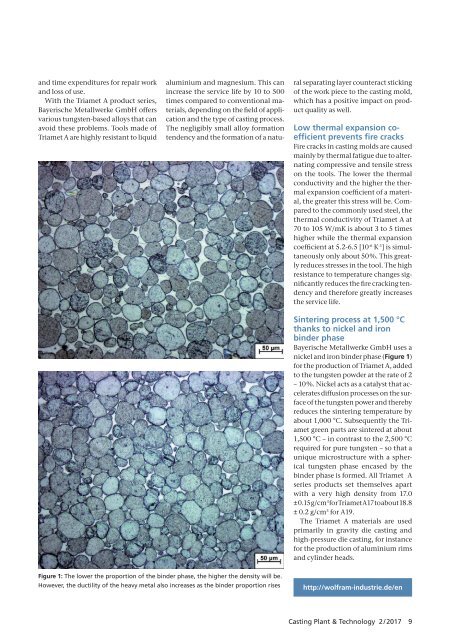CPT International 02/2017
The leading technical journal for the global foundry industry – Das führende Fachmagazin für die weltweite Gießerei-Industrie
The leading technical journal for the
global foundry industry – Das führende Fachmagazin für die
weltweite Gießerei-Industrie
Create successful ePaper yourself
Turn your PDF publications into a flip-book with our unique Google optimized e-Paper software.
and time expenditures for repair work<br />
and loss of use.<br />
With the Triamet A product series,<br />
Bayerische Metallwerke GmbH offers<br />
various tungsten-based alloys that can<br />
avoid these problems. Tools made of<br />
Triamet A are highly resistant to liquid<br />
aluminium and magnesium. This can<br />
increase the service life by 10 to 500<br />
times compared to conventional materials,<br />
depending on the field of application<br />
and the type of casting process.<br />
The negligibly small alloy formation<br />
tendency and the formation of a natural<br />
separating layer counteract sticking<br />
of the work piece to the casting mold,<br />
which has a positive impact on product<br />
quality as well.<br />
Low thermal expansion co-<br />
<br />
Fire cracks in casting molds are caused<br />
mainly by thermal fatigue due to alternating<br />
compressive and tensile stress<br />
on the tools. The lower the thermal<br />
conductivity and the higher the thermal<br />
expansion coefficient of a material,<br />
the greater this stress will be. Compared<br />
to the commonly used steel, the<br />
thermal conductivity of Triamet A at<br />
70 to 105 W/mK is about 3 to 5 times<br />
higher while the thermal expansion<br />
coefficient at 5.2-6.5 [10 -6 K -1 ] is simultaneously<br />
only about 50 %. This greatly<br />
reduces stresses in the tool. The high<br />
resistance to temperature changes significantly<br />
reduces the fire cracking tendency<br />
and therefore greatly increases<br />
the service life.<br />
<br />
<br />
binder phase<br />
Bayerische Metallwerke GmbH uses a<br />
nickel and iron binder phase (Figure 1)<br />
for the production of Triamet A, added<br />
to the tungsten powder at the rate of 2<br />
– 10 %. Nickel acts as a catalyst that accelerates<br />
diffusion processes on the surface<br />
of the tungsten power and thereby<br />
reduces the sintering temperature by<br />
about 1,000 °C. Subsequently the Triamet<br />
green parts are sintered at about<br />
1,500 °C – in contrast to the 2,500 °C<br />
required for pure tungsten – so that a<br />
unique microstructure with a spherical<br />
tungsten phase encased by the<br />
binder phase is formed. All Triamet A<br />
series products set themselves apart<br />
with a very high density from 17.0<br />
± 0.15 g/cm 3 for Triamet A17 to about 18.8<br />
± 0.2 g/cm 3 for A19.<br />
The Triamet A materials are used<br />
primarily in gravity die casting and<br />
high-pressure die casting, for instance<br />
for the production of aluminium rims<br />
and cylinder heads.<br />
Figure 1: The lower the proportion of the binder phase, the higher the density will be.<br />
However, the ductility of the heavy metal also increases as the binder proportion rises<br />
http://wolfram-industrie.de/en<br />
Casting Plant & Technology 2 / <strong>2017</strong> 9


















